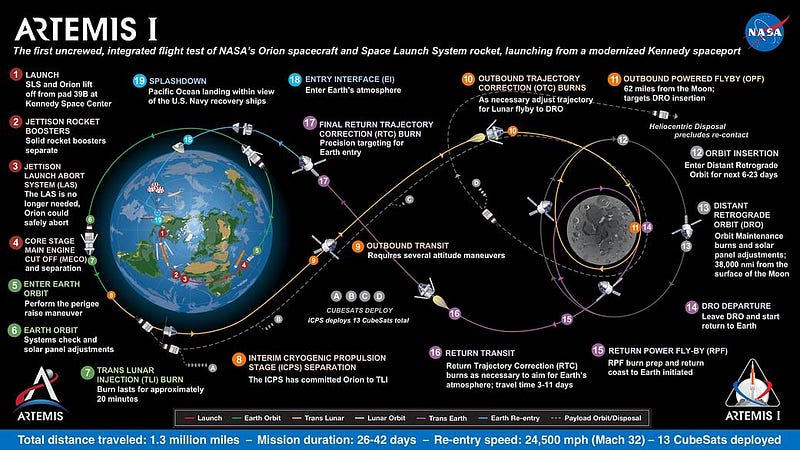The Orion Spacecraft's Historic Splashdown: A New Era Begins
Written on
Chapter 1: The Return of Orion
The Orion spacecraft from NASA's Artemis 1 mission has triumphantly splashed down back on Earth. After an impressive journey of 25.5 days covering 2.26 million kilometers, Orion's return went exactly as planned, suggesting that human missions to the Moon could commence in just a year and a half. Details about the crew for the Artemis 2 mission are anticipated to be announced in early 2023.
> NASA's successful Orion splashdown marks a significant achievement in space exploration.
Section 1.1: The Journey Home
The Orion spacecraft, launched by the Space Launch System (SLS) rocket, had to undergo a remarkable deceleration from 40,000 kilometers per hour to just 32 kilometers per hour in under 90 minutes. This careful reduction in speed allowed for a smooth descent into the Pacific Ocean. Prior to landing, the service module—crucial for various orbital tasks—was ejected, and Orion's heat shield faced extreme conditions, reaching temperatures close to 3,000 degrees Celsius.
When entering the atmosphere at 32 times the speed of sound, compression waves raised the outer shields to 2,760 degrees Celsius, a temperature that is half that of the Sun. To prepare for such harsh conditions, the heat shield underwent rigorous testing, simulating the intense heat and pressure during re-entry. The heat shield utilizes an ablative material known as Avcoat, which melts upon atmospheric entry to absorb and dissipate heat. The new tile system, varying between 2.5 and 8 cm in thickness, ensured that while the front of the spacecraft reached extreme temperatures, the rear remained at a manageable 90 degrees Celsius.
Another critical maneuver, known as "skip entry," allowed the spacecraft to bounce off the atmosphere momentarily before re-entering, reducing both speed and friction. This method not only enhances safety for astronauts but also aids ground teams in coordinating rescue efforts more effectively, according to Lockheed Martin’s Joe Bomba.
Section 1.2: Splashdown and Recovery
After completing its descent, Orion deployed a series of 11 parachutes to slow its landing into the Pacific Ocean. A specialized team from NASA and the U.S. Navy was on standby to recover the spacecraft, which was initially tracked by helicopters that marked the landing site with smoke. Orion floated for approximately six hours before being retrieved by the USS Portland and then transported to San Diego for analysis.
Next, engineers will conduct thorough examinations of the spacecraft while collecting data from three dummies—Campos, Helga, and Zohar—equipped with sensors. This data will help assess the conditions astronauts will face during extended lunar missions, particularly regarding cosmic radiation—an ongoing challenge for future missions. While Apollo missions lasted around eight days, Artemis 1 extended over 25 days, indicating that longer missions are on the horizon.

Chapter 2: Preparing for Artemis 2
As preparations for Artemis 2 ramp up, the crew for this mission will be announced soon. This upcoming flight aims to replicate Artemis 1, but this time with astronauts aboard the Orion spacecraft. The goal is to land near the Moon's south pole by 2025 or 2026.
Interestingly, Orion's return coincided with the 50th anniversary of Apollo 17's landing, which was the last mission to the Moon. While it might seem that flying to the Moon is a familiar endeavor, the upcoming missions are focused on establishing a sustainable presence on the lunar surface. The Orion spacecraft is set to serve as a reliable vessel, facilitating not just landings but also the transportation of astronauts and supplies to a future lunar base.
This first Artemis mission served as a vital test of Orion's capabilities, revealing some challenges, including issues with the power system and an ammonia leak. However, the successful resolution of these problems demonstrates the extensive preparation undertaken by engineers worldwide for this historic undertaking. The Orion capsule has safely returned, and the European Service Module (ESM), developed by Airbus Defence and Space, has disintegrated upon re-entry. Analysis of data from this mission is now underway.
The Artemis program is not only a NASA achievement but also a significant accomplishment for Airbus, showcasing the ESM's capabilities without major anomalies. This success lays the groundwork for future crewed missions, ensuring that the advancements in space technology continue to pave the way for humanity's exploration of the cosmos.
The oldest narrative sculpture in history has been discovered!
11,000 years old. That’s how old the sculpture discovered in Turkey is. What does it depict? A man holding his…
Cool that you made it to the end of this article. I would greatly appreciate your feedback and support. Please leave a clap, follow me, or even consider a tip! Thank you!